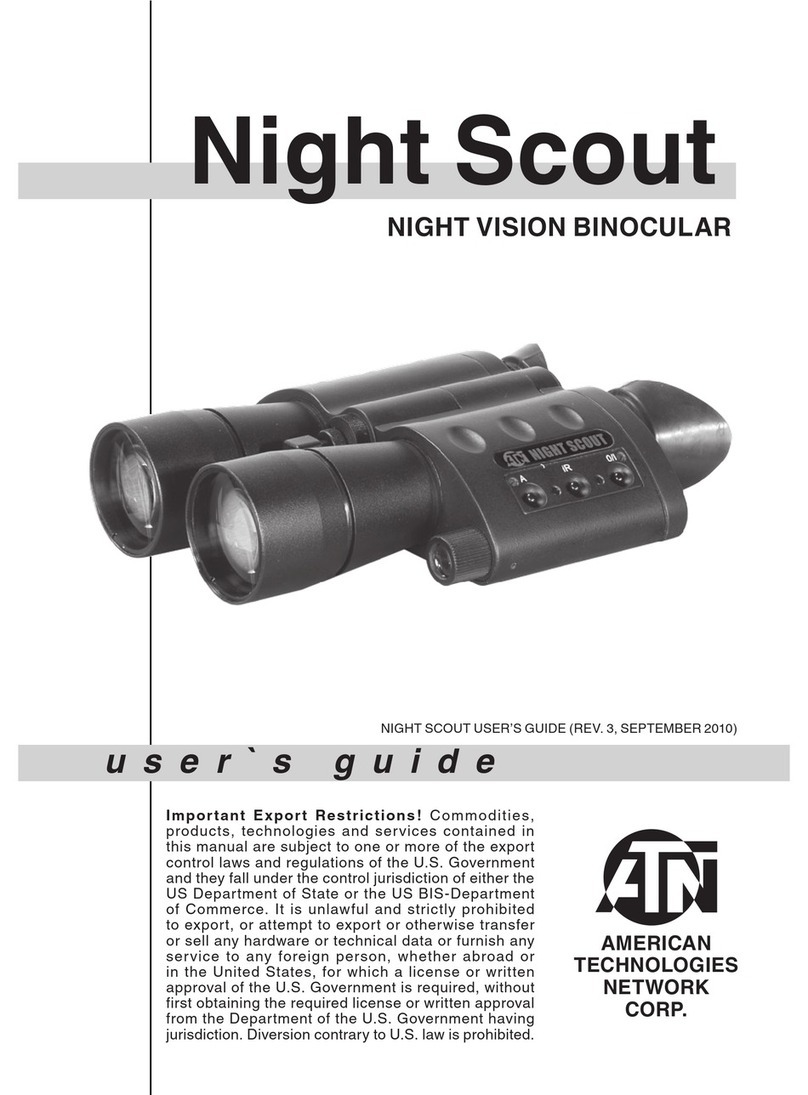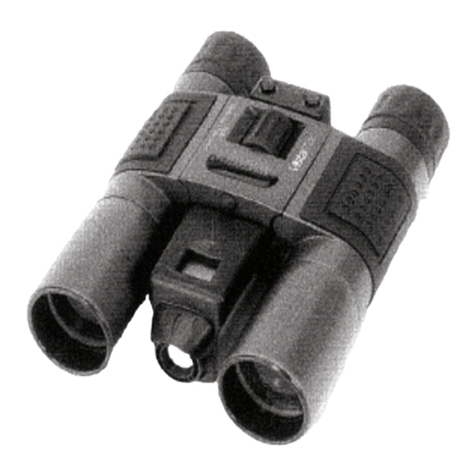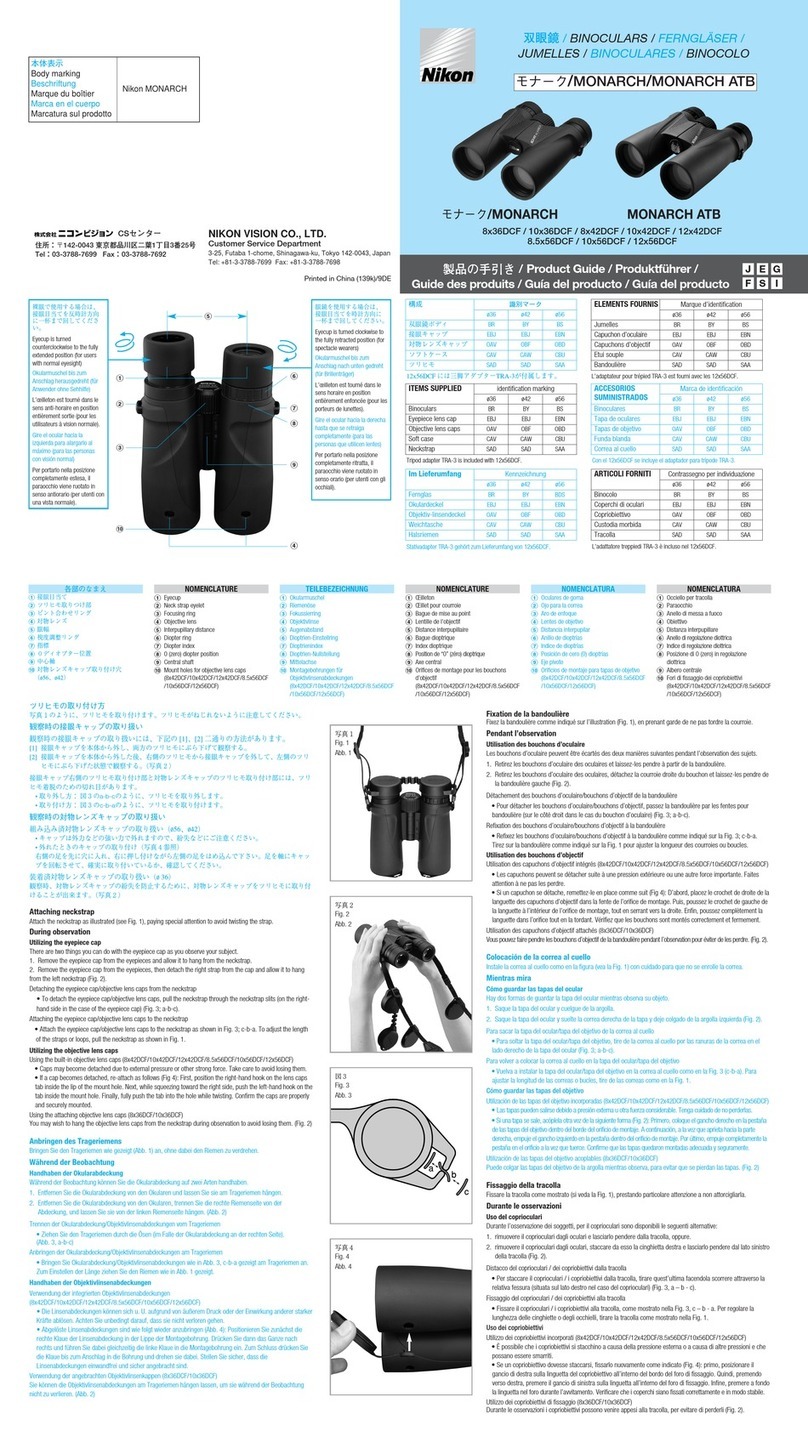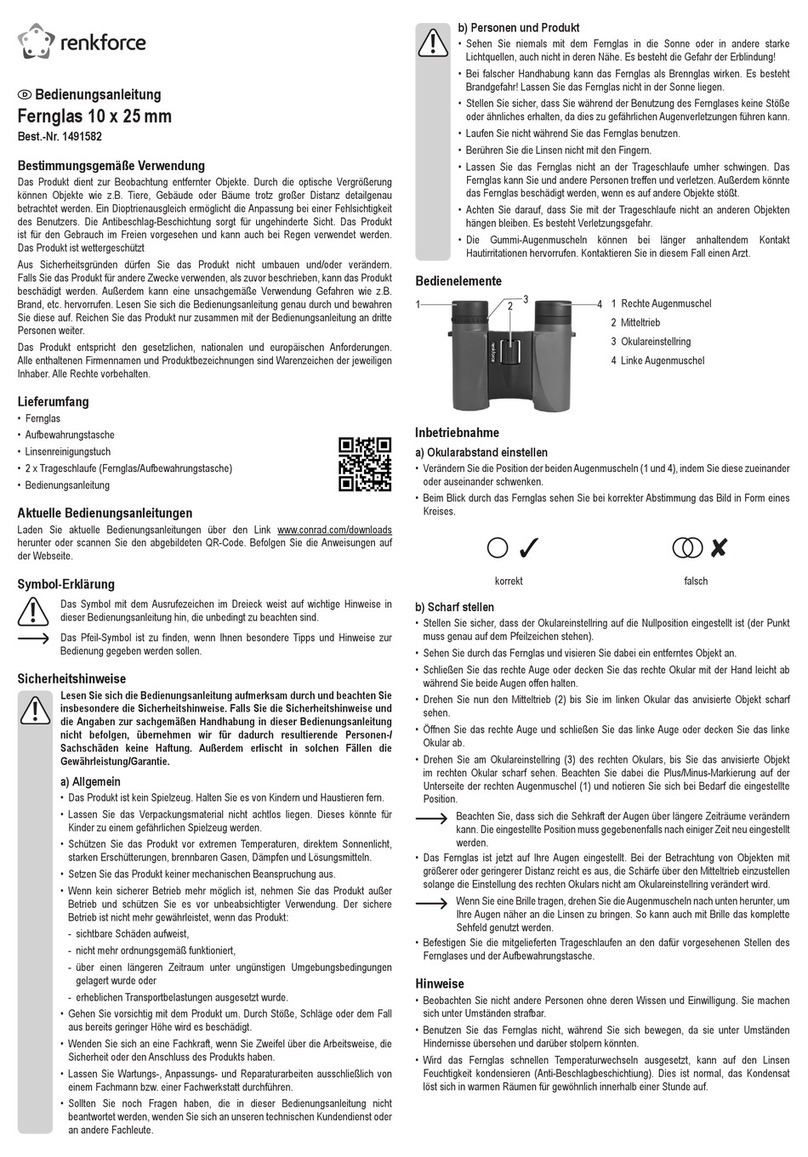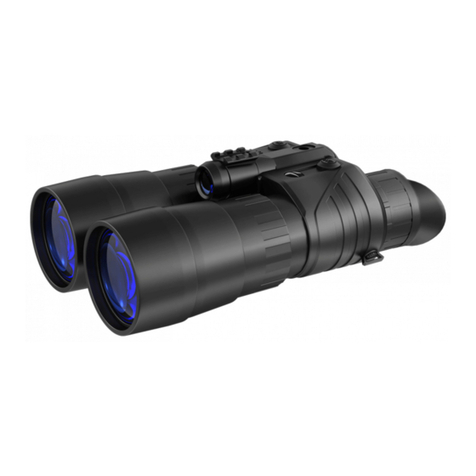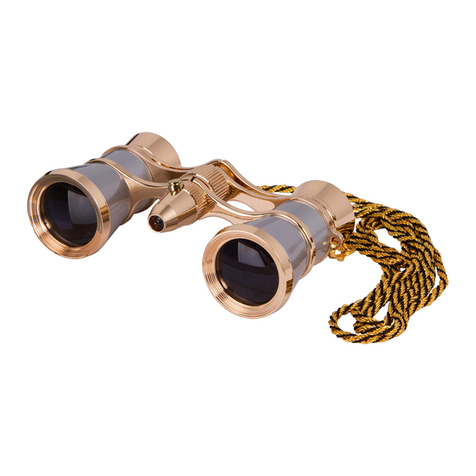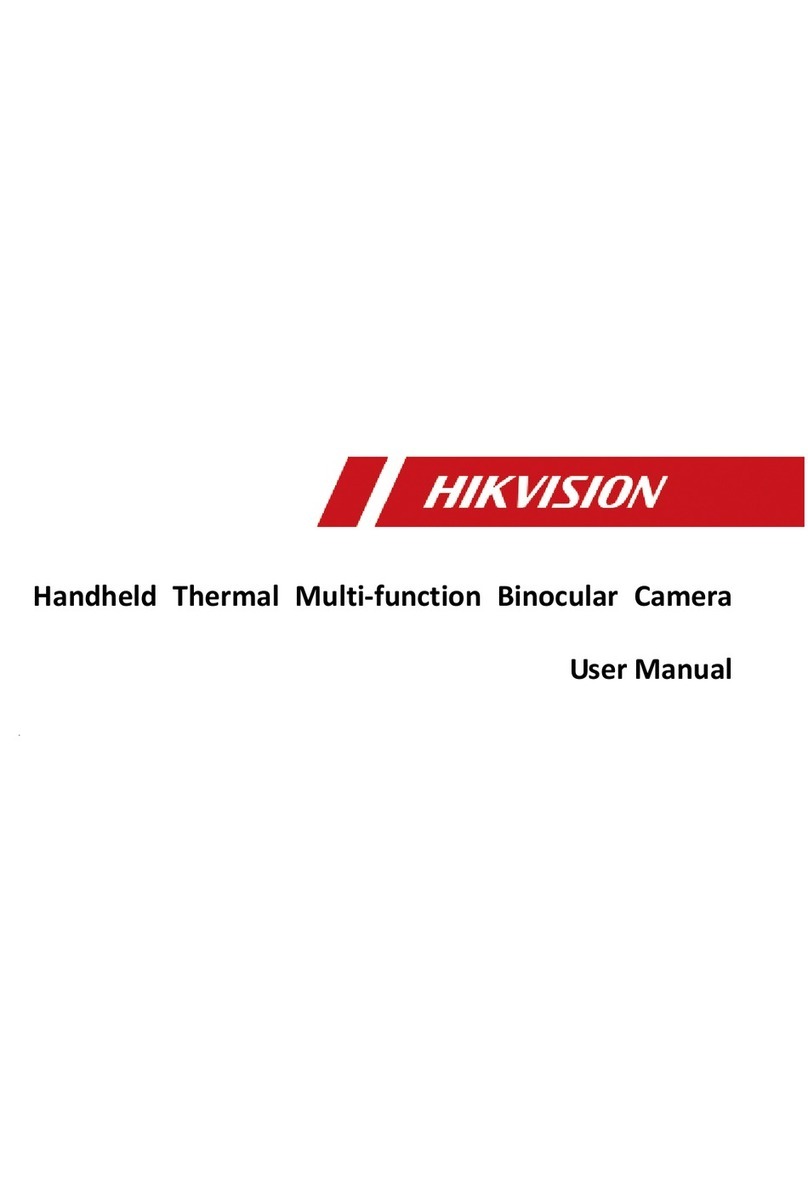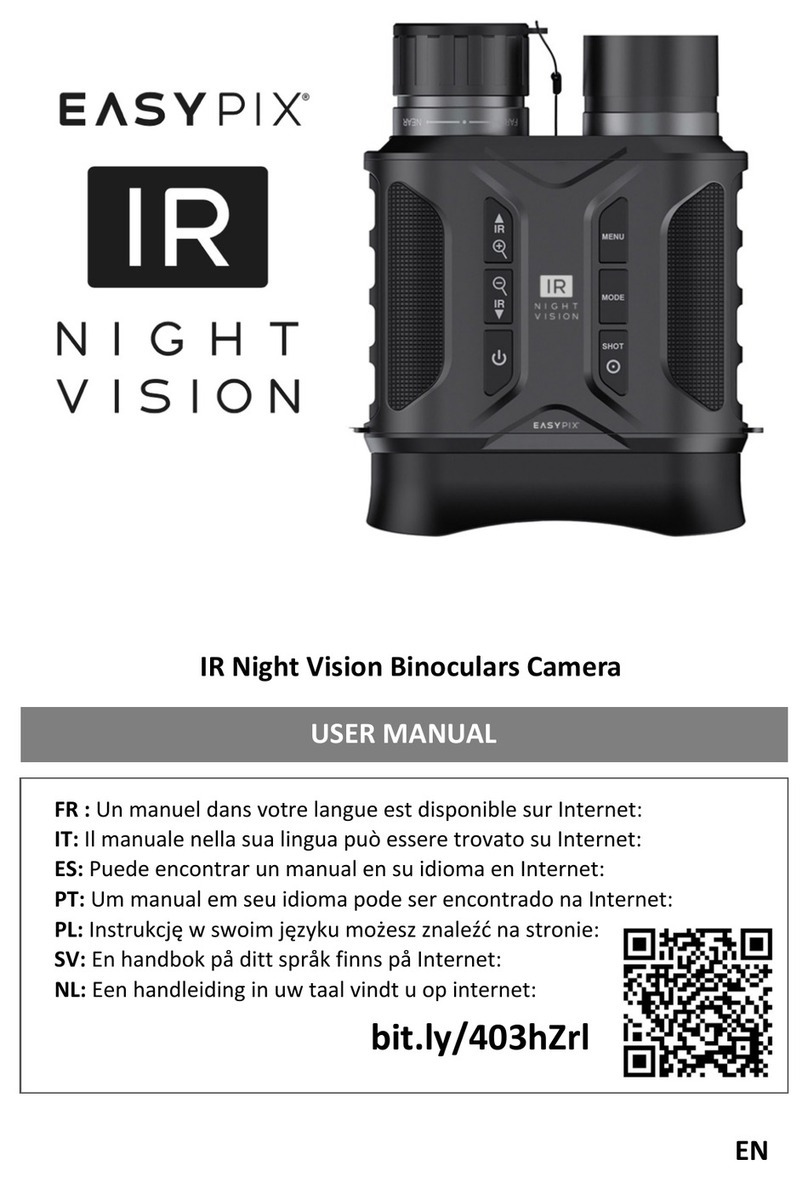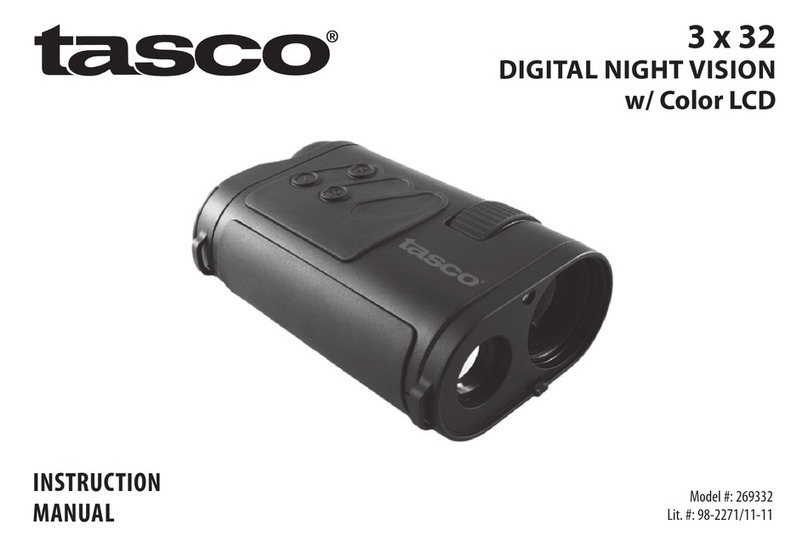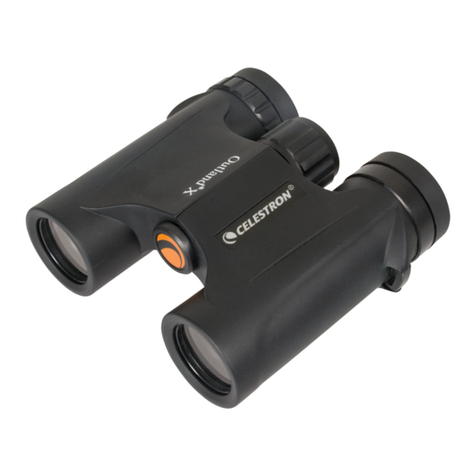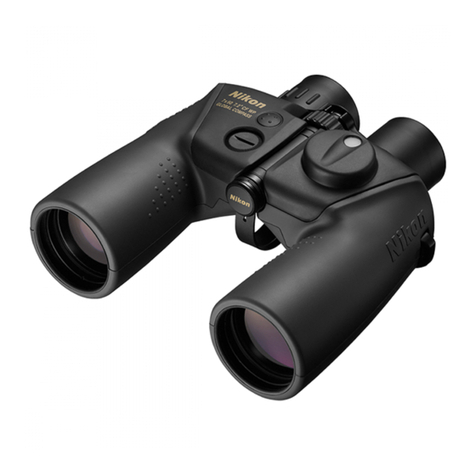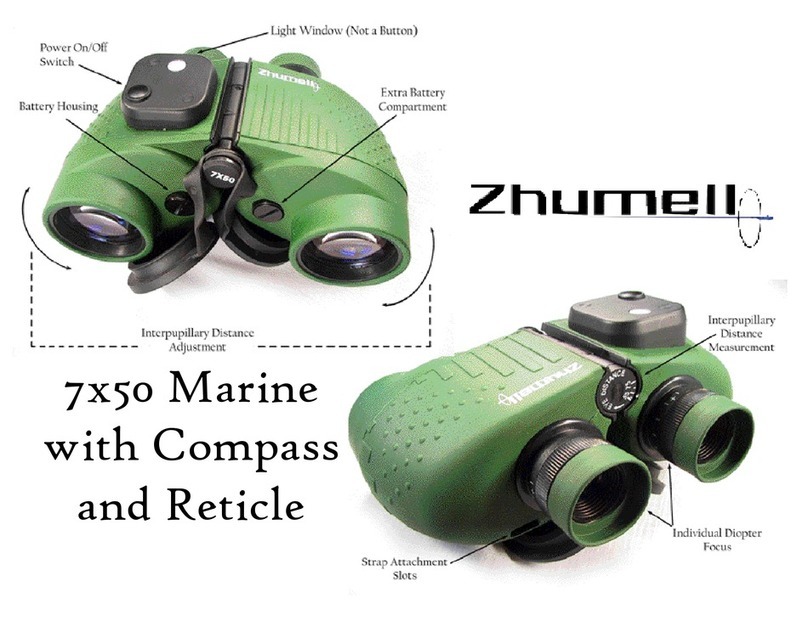SVBONY SA205 User manual

Binoculars Instruction
SA205
User Manual


Contents
EN(01-09)
DE(10-18)
FR(19-27)
IT(28-36)
ES(37-45)
RU(46-54)
JP(55-63)
-------------------------------------03
-----------------------------03
------------------------------04
---------------------------------------------05
------------------------------------------07
--------------------------------08
--------------------------------------------------64
Appearance Introduction
Setting Twist-up Rubber Eyecups
Adjusting Interpupilla Distance
Adjusting Focus
Tripod Adaptability
Maintenance and Precautions
Guarantee
Address: Uetzenacker 29,38176 wendeburg
EU Impoer: Germany Retevis Technology GmbH

01
To Customers
Thanks for purchasing SVBONY binoculars.
Whether your interest is in spos, bird watching,
nature, wildlife, hunting, or other activities, we will
oer you the nest quality of optical products to
guarantee you have more viewing pleasure.
This manual will give you a brief introduction of
SA205 binoculars. Please read the manual
completely before using it and feel free to contact
us if you have any questions, thanks.
Email: info@svbony.com
Website: www.svbony.com
Facebook: www.facebook.com/svbony

02
CAUTIONS
CAUTION
●Do not place the binoculars in an unstable position. If it falls or
tips over, inju or damage may occur
●Do not use binoculars when walking, riding a bicycle or driving
to avoid accidents or injuries to yourself and others.
●Attach the neck strap to the binoculars to prevent them from
falling. Do not swing the binoculars by the strap as it may hit
people or other objects, causing inju or damage to the object
and product.
●Never place the binoculars in a car or near a heat source as this
may cause damage to the product or cause re.
●The casing, neck strap and rubber pas of the binoculars may
deteriorate during use or storage.
●Prolonged or prolonged contact with rubber pas may cause
skin inammation or irritation. If this occurs, please consult your
doctor.
●The moving pas of the binoculars may trap your ngers; be
careful with the movement, especially if the binoculars are being
used by children.
*SVBONY is not responsible for any damage caused by improper handling or
natural disasters such as re, eahquakes, oods, etc.
*SVBONY is not responsible for any damage caused by unauthorized seice
companies.

03
Appearance Introduction
Setting Twist-up Rubber Eyecups
The binoculars have a pair of twist-up eyecups, for wearing eyeglass users.
•Twist down the eyecups to get a full eld of view when you obseing wear
eyeglasses.
•Twist down the eyecups when you obseing without wearing eyeglasses.
Eyecups
Strap
buckle
Objective
lens
Focus wheel
Dioptre ring
Centre
shaft cove
How to use the twist up eyecup
Clockwise rotation
(for glasses wearing)
Anticlockwise rotation
(without glasses wearing)

04
Adjusting Interpupilla Distance
Since the distance between the eyes varies among individuals (Specically, the
distance between the centers of your pupils), the two eyepieces of the
binoculars must be correctly aligned your pupils when you use it.
Use hands lift the binoculars up to your eyes to view an object, move the
centre hinge of the binoculars until see one clear circle of image through the
appropriate interpupilla distance.
Pupil distance adjustment
Rotate each tube at the same time
Glasses
Glasses

05
Adjusting Focus
Dierent people have dierent levels of vision, which requires you to adjust
the focus when you use the SA205. Please follow the steps below to achieve
the binoculars focus
•Close your right eye and look through the left side of the binoculars with
your left eye at the subject matter. Rotate the center focusing wheel until the
image appears in sharp focus.
•Close your left eye and look through the right eyepiece (called the diopter).
Rotate the right eyepiece until the image appears in sharp focus.
•Open your two eyes and look through both eyepieces of your binoculars .
Once adjusted your the right eyepiece, use only the center focusing wheel to
refocus on a new object at a dierent distance.
Notes:
The binocular with a diopter indicator, please note the tips to use it for
focusing settings so that adjust your focus rapidly in the future.
If your vision is not well, please wear glasses that are appropriate for your
vision level when using the SA205, otherwise you may not experience the clear
viewing with the binoculars.
Adjust the pupil distance until you can see a
whole circle to get the best images
Diopter adjustment of Cent. binoculars
Focus wheel
Left
Obsee only by left eye rst and
turn the focus wheel until the
image is clear

06
Dioptre ring
Right
Observe only by right eye then and
turn the diopter ring until the image
is clear. (The diopter ring won`t be
adjusted again if this binocular is
only used by one person)
Focus wheel
Left Right
Observe by two eyes and turn the
focus wheel until the image is
clear. (After the first adjustment,
there is no need to repeat the
above two steps if you change
another objects to observe)
Left
Diopter adjustment of Ind. binoculars
Right
Left focus wheel
Right focus ring
Observe only by left eye first and
turn the focus wheel until the
image is clear
Left Right
Observe by two eyes and turn the
focus wheel until the image is
clear. (After the first adjustment,
there is no need to repeat the
above two steps if you change
another objects to observe)
Observe only by right eye then and
turn the diopter ring until the image
is clear . (The diopter ring won`t be
adjusted again if this binocular is
only used by one person)

07
Tripod Adaptability
The one of features for the binoculars that is a built-in tripod adapter tting.
Follow the below graphic instructions to install the tting tripod, if you need a
better and more comfoable viewing experience.
•Remove the binoculars center shaft cover to attach a tripod adapter
•Thread the screw from the tripod adapter into the binoculars center shaft
thread.
•The other end of the tripod adapter to attache a photographic tripod.
Center shaft thread
Center shaft
cover
Adapter
screw
Adapter thread
connector
Adapter connector
Tripod screw

08
Do not view the sun or other intense light with your products or
even with the naked eye; Otherwise there may permanent eye
damage.
Do not put the plastic package in a place your kids can reach. If
not, the kids may put the plastic into their mouth and suffer from
suffocating.
Always supervise children using an optical device.
Maintenance and Precautions
Care and Clean
The item does not need routine maintenance other than making sure that the
objective lenses and eyepieces are kept clean. Diy objectives and/or
eyepieces mean less light transmission and loss of brightness as well as
unsharp images. Keep your optical device clean! When not using your item,
store those in the case provided.
Usage Notice
1. Store the product in a ventilated, d, clean place or put it in a d box.
2.If there is dust and other di on the optical lens, use a professional cleaning
kit to clean it. Do not wipe it directly with a cloth and a hard brush.
3.Please do not disassemble or repair the product yourself. If you need to
repair it, please contact our professional after-sales depament.
4.Do not use non-waterproof products in wet environments, use waterproof
products in wet environments, and d them after use.
5.When viewing indoors, please do not close the window and watch it through
the window, which will reduce the product obseation eect.
6.No matter what recommended technique you use, do not stare continuously
at the sun. Take breaks and give your eyes a rest!
Viewing with Protection
Always inspect your solar lter before use; if scratched or damaged, discard it.
Read and follow any instructions printed on or packaged with the lter. Note
that solar lters must be attached to the front of any telescope, binoculars,
camera lens, or other optics.
Do not look at the uneclipsed or paially eclipsed sun through an unltered
camera, telescope, binoculars, or other optical device. Similarly, do not look at
the sun through a camera, a telescope, binoculars, or any other optical device
while using your eclipse glasses or hand-held solar viewer — the concentrat-
ed solar rays will damage the lter and enter your eye (s), causing serious
WARNING
inju.
If you normally wear eyeglasses, keep them on. Put your eclipse glasses on
over them, or hold your handheld viewer in front of them.
Seek expe advice from an astronomer before using a solar lter with a
camera, a telescope, binoculars, or any other optical device.
Avoid Choking Hazard
Authorized Accessories Lis
•Authorized Accessories meets the regulato standards when used with the
Svbony accessories supplied or designated for the product.
•For a list of Svbony-approved accessories for your item, visit the following
website: http://www.svbony.com

09
Care and Clean
The item does not need routine maintenance other than making sure that the
objective lenses and eyepieces are kept clean. Diy objectives and/or
eyepieces mean less light transmission and loss of brightness as well as
unsharp images. Keep your optical device clean! When not using your item,
store those in the case provided.
Usage Notice
1. Store the product in a ventilated, d, clean place or put it in a d box.
2.If there is dust and other di on the optical lens, use a professional cleaning
kit to clean it. Do not wipe it directly with a cloth and a hard brush.
3.Please do not disassemble or repair the product yourself. If you need to
repair it, please contact our professional after-sales depament.
4.Do not use non-waterproof products in wet environments, use waterproof
products in wet environments, and d them after use.
5.When viewing indoors, please do not close the window and watch it through
the window, which will reduce the product obseation eect.
6.No matter what recommended technique you use, do not stare continuously
at the sun. Take breaks and give your eyes a rest!
Viewing with Protection
Always inspect your solar lter before use; if scratched or damaged, discard it.
Read and follow any instructions printed on or packaged with the lter. Note
that solar lters must be attached to the front of any telescope, binoculars,
camera lens, or other optics.
Do not look at the uneclipsed or paially eclipsed sun through an unltered
camera, telescope, binoculars, or other optical device. Similarly, do not look at
the sun through a camera, a telescope, binoculars, or any other optical device
while using your eclipse glasses or hand-held solar viewer — the concentrat-
ed solar rays will damage the lter and enter your eye (s), causing serious
inju.
If you normally wear eyeglasses, keep them on. Put your eclipse glasses on
over them, or hold your handheld viewer in front of them.
Seek expe advice from an astronomer before using a solar lter with a
camera, a telescope, binoculars, or any other optical device.
Avoid Choking Hazard
Authorized Accessories Lis
•Authorized Accessories meets the regulato standards when used with the
Svbony accessories supplied or designated for the product.
•For a list of Svbony-approved accessories for your item, visit the following
website: http://www.svbony.com
WARINING:CHOKING HAZARD-Small Pas. Not suitable for
children under 3 years old.

10
Zu Kunden
Vielen Dank, dass Sie sich für ein SVBONY-Fernglas
entschieden haben. Ganz gleich, ob Sie sich für
Spo, Vogelbeobachtung, Natur, Wildtiere, Jagd
oder andere Aktivitäten interessieren, wir bieten
Ihnen optische Produkte von höchster Qualität, um
Ihnen mehr Sehvergnügen zu garantieren.
Dieses Handbuch gibt Ihnen eine kurze Einführung
in das SA205-Fernglas. Bitte lesen Sie das
Handbuch vollständig durch, bevor Sie es
verwenden. Wenn Sie Fragen haben, können Sie
sich jederzeit an uns wenden. Vielen Dank.
E-Mail: info@svbony.com
Website: www.svbony.com
Facebook: www.facebook.com/svbony

11
VORSICHTSHINWEISE
●Stellen Sie das Fernglas nicht in einer instabilen Position auf.
Wenn es herunteällt oder umkippt, kann es zu Verletzungen
oder Schäden kommen
●Benutzen Sie das Fernglas nicht beim Gehen, Radfahren oder
Autofahren, um Unfälle oder Verletzungen bei Ihnen und anderen
zu vermeiden.
●Befestigen Sie den Tragegu am Fernglas, um ein Herunteall-
en zu verhindern. Schwingen Sie das Fernglas nicht am Riemen,
da es Personen oder andere Gegenstände treen und
Verletzungen oder Schäden am Gegenstand und am Produkt
verursachen könnte.
●Lassen Sie das Fernglas niemals im Auto oder in der Nähe einer
Wärmequelle liegen, da dies zu Schäden am Produkt oder einem
Brand führen kann.
●Das Gehäuse, der Trageriemen und die Gummiteile des
Fernglases können während der Verwendung oder Lagerung
beschädigt werden.
●Längerer oder andauernder Kontakt mit Gummiteilen kann zu
Hautentzündungen oder Reizungen führen. Wenn dies geschieht,
konsultieren Sie Ihren Arzt.
●Die beweglichen Teile des Fernglases können Ihre Finger
einklemmen; seien Sie vorsichtig bei der Bewegung, insbesonde-
re wenn das Fernglas von kleinen Kindern benutzt wird.
*SVBONY ist nicht verantwolich für Schäden, die durch unsachgemäße
Handhabung oder Naturkatastrophen wie Brände, Erdbeben, Überschwem-
mungen usw. verursacht werden.
*SVBONY ist nicht verantwolich für Schäden, die durch nicht autorisiee
Seiceunternehmen verursacht werden.
Beachten

12
Einführung in das Aussehen
Einstellen der hochdrehbaren Gummi-Augenmuscheln
Das Fernglas veügt über ein Paar hochdrehbare Augenmuscheln für
Brillenträger.
•Drehen Sie die Augenmuscheln herunter, um beim Beobachten mit Brille ein
volles Sichtfeld zu erhalten.
•Drehen Sie die Augenmuscheln herunter, wenn Sie ohne Brille beobachten.
Augen-
muscheln
Riemen-
schnalle
Objektivlinse
Fokusrad
Dioptrienring
Mittelwel-
lenabdeck-
ung
So verwenden Sie die Augenmuschel
Drehung im Uhrzeigersinn
(Für Brilleräger)
Drehung gegen den Uhrzigersinn
(ohne Brillenträger)

13
Anpassen des Augenabstands
Da der Abstand zwischen den Augen von Person zu Person unterschiedlich ist
(insbesondere der Abstand zwischen den Mittelpunkten Ihrer Pupillen),
müssen die beiden Okulare des Fernglases bei der Verwendung korrekt auf
Ihre Pupillen ausgerichtet sein.
Heben Sie das Fernglas mit den Händen an Ihre Augen, um ein Objekt zu
betrachten, und bewegen Sie das Mittelscharnier des Fernglases, bis Sie einen
klaren Bildkreis durch den entsprechenden Augenabstand sehen.
Brille
Brille
Pupillenabstand einstellen
Drehen Sie jedes Röhrchen gleichzeitig

14
Fokus anpassen
Verschiedene Menschen haben unterschiedliche Sehstärken, weshalb Sie bei
der Verwendung des SA205 den Fokus anpassen müssen. Bitte befolgen Sie die
folgenden Schritte, um den Fokus des Fernglases zu erreichen
•Schließen Sie Ihr rechtes Auge und schauen Sie mit dem linken Auge durch
die linke Seite des Fernglases auf das Motiv. Drehen Sie das mittlere
Fokussierrad, bis das Bild scharf angezeigt wird.
•Schließen Sie Ihr linkes Auge und schauen Sie durch das rechte Okular
(Dioptrie genannt). Drehen Sie das rechte Okular, bis das Bild scharf erscheint.
•Öffnen Sie Ihre beiden Augen und schauen Sie durch beide Okulare Ihres
Fernglases. Sobald Sie das rechte Okular eingestellt haben, verwenden Sie nur
das mittlere Fokussierrad, um auf ein neues Objekt in einer anderen Entfernung
zu fokussieren.
Anmerkungen:
Wenn Sie ein Fernglas mit Dioptrienanzeige haben, beachten Sie bitte die Tipps
zur Fokussierung, damit Sie Ihren Fokus in Zukunft schnell anpassen können.
Wenn Ihre Sicht nicht gut ist, tragen Sie bitte bei der Verwendung des SA205
eine Brille, die für Ihre Sehstärke geeignet ist, da Sie sonst möglicherweise keine
klare Sicht mit dem Fernglas haben.
Passen Sie den Pupillenabstand an, bis Sie einen ganzen Kreis
sehen können, um die besten Bilder
Dioptrieneinstellung von Cent. Fernglas
Fokusring
links
Beobachten Sie nur mit dem linken
Auge und drehen Sie das
Fokussierrad,
bis das Bild klar ist.

15
Dioptrie Ring
rechts
Fokusring
links rechts
Beobachten Sie nur mit dem
rechten Auge und drehen Sie den
Dioptrienring, bis das Bild klar ist.
(Der Dioptrienring wird nicht erneut
eingestellt, wenn dieses Fernglas
nur von einer Person verwendet
wird.)
Mit zweiAugen beobachten und
das Fokussierrad drehen, bis das
Bild klar ist. (Nach der ersten
Einstellung müssen Sie die o.g.
zwei Schritte nicht wiederholen,
wenn Sie andere Objekte ändern,
um sie zu beobachten)
links
links
Dioptrieneinstellung von Ind. Fernglas
rechts
rechts
Fokusring
Dioptrie Ring
Beobachten Sie nur mit dem linken
Auge und drehen Sie das
Fokussierrad bis das Bild klar ist.
Dann nur mit dem rechten Auge
beobachten und den Dioptrienring
drehen bis das Bild klar ist.(Der
Dioptrienring wird nicht erneut
eingestellt, wenn dieses Fernglas
nur von einer Person verwendet
wird.)
Mit zwei Augen beobachten und
das Fokussierrad drehen, bis das
Bild klar ist. (Nach der ersten
Einstellung müssen Sie die o.g.
zwei Schritte nicht wiederholen,
wenn Sie andere Objekte ändern,
um sie zu beobachten)

16
Stativanpassungsfähigkeit
Eines der Merkmale des Fernglases ist ein integrieer Stativadapter.
Befolgen Sie die nachstehenden graschen Anweisungen, um das passende
Stativ zu installieren, wenn Sie ein besseres und komfoableres Seherlebnis
wünschen.
•Entfernen Sie die mittlere Schaftabdeckung des Fernglases, um einen
Stativadapter anzubringen
•Schrauben Sie die Schraube vom Stativadapter in das Gewinde des
Mittelschafts des Fernglases.
•Das andere Ende des Stativadapters dient zur Befestigung eines Fotostativs.
Mittelachse
Mittelachse
Abdeckung
Adapter-
schraube Adapteransc
Adapteranschluß
Stativschraube

Pege und Sauberkeit
Der Aikel beda keiner routinemäßigen Waung, außer sicherzustellen, dass
die Objektivlinsen und Okulare sauber gehalten werden. Verschmutzte
Objektive und/oder Okulare führen zu geringerer Lichtdurchlässigkeit und
Helligkeitsverlust sowie zu unschaen Bildern. Halten Sie Ihr optisches Gerät
sauber! Wenn Sie Ihren Aikel nicht verwenden, bewahren Sie ihn in der
mitgeliefeen Hülle auf.
Nutzungshinweis
1. Lagern Sie das Produkt an einem belüfteten, trockenen und sauberen O
oder legen Sie es in eine Trockenbox.
2. Wenn sich Staub und anderer Schmutz auf der optischen Linse bendet,
reinigen Sie sie mit einem professionellen Reinigungsset. Wischen Sie es nicht
direkt mit einem Tuch und einer haen Bürste ab.
3. Bitte zerlegen oder reparieren Sie das Produkt nicht selbst. Wenn Sie eine
Reparatur benötigen, wenden Sie sich bitte an unsere professionelle
Kundendienstabteilung.
4. Verwenden Sie keine nicht wasserdichten Produkte in nassen Umgebungen,
verwenden Sie wasserdichte Produkte in nassen Umgebungen und trocknen
Sie sie nach dem Gebrauch.
5. Schließen Sie beim Betrachten in Innenräumen bitte nicht das Fenster und
beobachten Sie es nicht durch das Fenster, da dies den Produktbeobach-
tungseekt verringe.
6. Egal welche empfohlene Technik Sie anwenden, starren Sie nicht ständig in
die Sonne. Machen Sie Pausen und gönnen Sie Ihren Augen eine Pause!
Betrachten mit Schutz
Überprüfen Sie Ihren Solailter immer vor der Verwendung; Wenn es zerkratzt
oder beschädigt ist, entsorgen Sie es. Lesen und befolgen Sie alle
Anweisungen, die auf dem Filter aufgedruckt oder ihm beiliegen. Beachten
Sie, dass Sonnenlter an der Vorderseite jedes Teleskops, Fernglases,
Kameraobjektivs oder anderer Optiken angebracht werden müssen.
Schauen Sie nicht durch eine ungeltee Kamera, ein Teleskop, ein Fernglas
oder ein anderes optisches Gerät in die unbedeckte oder teilweise veinstee
Sonne. Schauen Sie auch nicht durch eine Kamera, ein Teleskop, ein Fernglas
oder ein anderes optisches Gerät in die Sonne, während Sie Ihre Sonnenn-
sternisbrille oder Ihren tragbaren Sonnenbeobachter verwenden – die
konzentrieen Sonnenstrahlen beschädigen den Filter und dringen in Ihre
Augen ein. schwere Verletzungen verursachen.
Wenn Sie normalerweise eine Brille tragen, behalten Sie diese auf. Setzen Sie
Ihre Sonnennsternis-Brille darüber auf oder halten Sie Ihren Handheld-Be-
trachter davor.
Lassen Sie sich von einem Astronomen fachkundig beraten, bevor Sie einen
Sonnenlter mit einer Kamera, einem Teleskop, einem Fernglas oder einem
anderen optischen Gerät verwenden.
Erstickungsgefahr vermeiden
Liste der autorisieen Zubehöeile
•Autorisiees Zubehör eüllt die gesetzlichen Standards, wenn es mit dem
mitgeliefeen oder für das Produkt vorgesehenen Svbony-Zubehör
verwendet wird.
•Eine Liste des von Svbony zugelassenen Zubehörs für Ihren Aikel nden
Sie auf der folgenden Website: http://www.svbony.com
17
Waung und Vorsichtsmaßnahmen
WARNUNG
Setzen Sie Ihre Produkte nicht der Sonne oder anderem
intensiven Licht aus, auch nicht mit bloßem Auge. Andernfalls
kann es zu bleibenden Augenschäden kommen.
Bewahren Sie die Plastikverpackung nicht an einem O auf,
den Ihre Kinder erreichen können. Andernfalls besteht die
Gefahr, dass die Kinder das Plastik in den Mund nehmen und
ersticken.
Beaufsichtigen Sie Kinder stets, wenn sie ein optisches Gerät
verwenden.
Table of contents
Languages:
Other SVBONY Binoculars manuals



